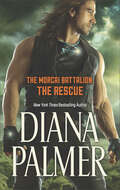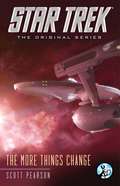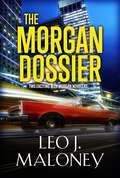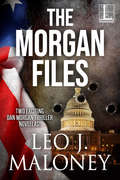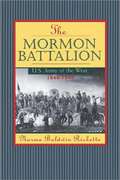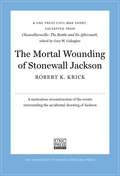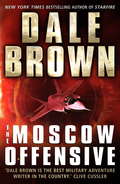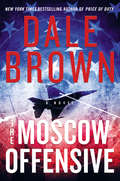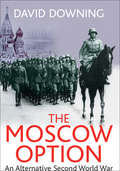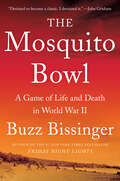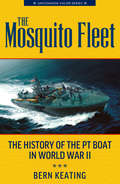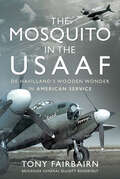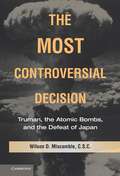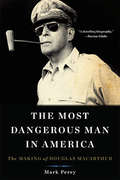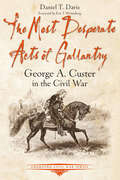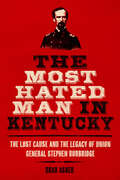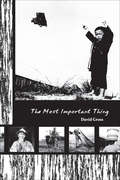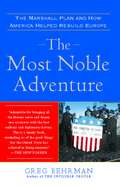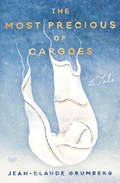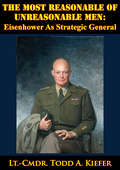- Table View
- List View
The Morcai Battalion: The Rescue (The Morcai Battalion #4)
by Diana PalmerA gruff military commander can&’t ignore his feelings for a shy colleague in this edge-of-your-seat, romantic space epic by a New York Times bestseller. Rhemun, commander of the Cehn-Tahr Holconcom, has worked tirelessly to get where he is—and he's not going to let any human drag him back down. Especially not Lt. Commander Edris Mallory, whose very presence aboard the Morcaiserves as a too-painful reminder of a past tragedy he can neither forgive nor forget. But Mallory has secrets of her own—ones she can&’t afford to see come to light. Frantic to protect herself, she flees, abandoning her position. When Rhemun learns of her devastating situation, he realizes the all-consuming feelings he's harbored for her may not be hatred. But in a vast universe rife with peril, is it already too late? Praise for The Morcai Battalion: Invictus &“This futuristic romance is action-packed and will please fans of Marcella Burnard and Katherine Allred. Readers new to the series will enjoy Kyle&’s well-conceived universe and the different modes of government and acceptable social interaction that make for a wealth of possibilities in this tale.&” —RT Book Reviews
The More Things Change (Star Trek: Vanguard )
by Scott PearsonA thrilling e-novella based on Star Trek: The Original Series! Six months after the events of Star Trek: The Motion Picture, Doctor Christine Chapel and Spock must save the life of an ailing Audrid Dax, her true nature as a Trill having remained a mystery until now. But after an unknown vessel attacks their shuttle, a risky game of cat-and-mouse may be the only way to save all their lives.
The Morgan Dossier: Two Exciting Dan Morgan Thriller Novellas (A Dan Morgan Thriller)
by Leo J. MaloneyOperative Dan Morgan is the ultimate force—an American hero weaponized for any contingency, his instincts honed to risk everything. Now you can read two heart-pounding Dan Morgan novellas in one electrifying volume. DARK TERRITORY Alex Morgan, daughter of CIA veteran Dan Morgan, is on a dangerous assignment outside Vladivostok, Russia, when she boards the Trans-Siberian Railway to make her escape. But she&’s not the only passenger with a hidden agenda. Now Dan Morgan has an impossible choice to make. Either he saves his daughter before fighter jets blow up the train, or he stops a madman from annihilating the world. Either way, this train ride is a one-way ticket to World War III. DEEP COVER Agents Dan Morgan and Peter Conley successfully got themselves thrown into prison in Istanbul. Now comes the hard part of the mission: extract a scientist who masterminded Turkey&’s new missile guidance system—without triggering a Middle East war. When an enemy from Morgan&’s past threatens the operation, the two agents face a desperate fight for their lives, with the fate of two hemispheres hanging in the balance. Praise for Leo J. Maloney and His Novels &“Maloney is the new master of the modern spy game.&”—Mark Sullivan &“Fine writing and real insider knowledge make this a must.&”—Lee Child on Twelve Hours &“Dan Morgan is one of the best heroes to come along in ages.&”—Jeffery Deaver &“Leo Maloney has a real winner . . . Gritty and intense, it draws you immediately into the action and doesn&’t let go.&”—Marc Cameron on For Duty and Honor &“Rings with authenticity.&”—John Gilstrap on Termination Orders
The Morgan Files (A Dan Morgan Thriller)
by Leo J. MaloneyWhen the world is pushed to the brink of disaster, there&’s only one man to call. Dan Morgan has been trained for any contingency and is prepared to risk everything—an American hero unlike any other. Now you can read two heart-pounding Dan Morgan novellas in one electrifying volume. TWELVE HOURS Exploding bombs, Islamic terrorists, and catastrophic battles have ruptured all sectors of New York City. They&’re part of an insidious plot targeting a visiting head of state. Dan Morgan knows what he has to do to prevent an irreversible domino effect designed to bring the world to its knees. There&’s just one catch. Morgan&’s teenage daughter is trapped among the hostages . . . FOR DUTY AND HONOR Captured by the Russians. Imprisoned in the Gulag. Tortured by his most sadistic enemy. But Dan Morgan knows that every prisoner has a past—and every rival can be used. That&’s when the stakes go sky-high. Dan Morgan&’s got to keep fighting. For duty. And honor. And even certain death . . . Praise for Leo J. Maloney and His Novels&“Fine writing and real insider knowledge make this a must.&”—Lee Child on Twelve Hours &“Leo Maloney has a real winner . . . Gritty and intense, it draws you immediately into the action and doesn&’t let go.&”—Marc Cameron on For Duty and Honor &“Dan Morgan is one of the best heroes to come along in ages.&”—Jeffery Deaver &“Rings with authenticity.&”—John Gilstrap on Termination Orders &“Maloney is the new master of the modern spy game.&”—Mark Sullivan Visit us at www.kensingtonbooks.com
The Mormon Battalion
by Norma RickettsFew events in the history of the American Far West from 1846 to 1849 did not involve the Mormon Battalion. The Battalion participated in the United States conquest of California and in the discovery of gold, opened four major wagon trails, and carried the news of gold east to an eager American public. Yet, the battalion is little known beyond Mormon history. This first complete history of the wide-ranging army unit restores it to its central place in Western history, and provides descendants a complete roster of the Battalion's members.
The Mortal Sickness: The Lydmouth Crime Series Book 2
by Andrew Taylor'Andrew Taylor is a master story-teller' Daily Telegraph From the No.1 bestselling author of The Ashes of London and The Fire Court, this is the second instalment in the acclaimed Lydmouth seriesWhen a spinster of the parish is found bludgeoned to death in St John's, and the church's most valuable possession, the Lydmouth chalice, is missing, the finger of suspicion points at the new vicar, who is already beset with problems.The glare of the police investigation reveals shabby secrets and private griefs. Jill Francis, struggling to find her feet in her new life, stumbles into the case at the beginning. But even a journalist cannot always watch from the sidelines. Soon she is inextricably involved in the Suttons' affairs. Despite the electric antagonism between her and Inspector Richard Thornhill, she has instincts that she can't ignore . . .'An excellent writer. He plots with care and intelligence and the solution to the mystery is satisfyingly chilling' The Times'The most under-rated crime writer in Britain today' Val McDermid 'There is no denying Taylor's talent, his prose exudes a quality uncommon among his contemporaries' Time Out
The Mortal Sickness: The Lydmouth Crime Series Book 2
by Andrew Taylor'Andrew Taylor is a master story-teller' Daily Telegraph From the No.1 bestselling author of The Ashes of London and The Fire Court, this is the second instalment in the acclaimed Lydmouth seriesWhen a spinster of the parish is found bludgeoned to death in St John's, and the church's most valuable possession, the Lydmouth chalice, is missing, the finger of suspicion points at the new vicar, who is already beset with problems.The glare of the police investigation reveals shabby secrets and private griefs. Jill Francis, struggling to find her feet in her new life, stumbles into the case at the beginning. But even a journalist cannot always watch from the sidelines. Soon she is inextricably involved in the Suttons' affairs. Despite the electric antagonism between her and Inspector Richard Thornhill, she has instincts that she can't ignore . . .'An excellent writer. He plots with care and intelligence and the solution to the mystery is satisfyingly chilling' The Times'The most under-rated crime writer in Britain today' Val McDermid 'There is no denying Taylor's talent, his prose exudes a quality uncommon among his contemporaries' Time Out
The Mortal Wounding of Stonewall Jackson
by Robert K. KrickThe stunning Confederate victory at Chancellorsville came at an enormous cost: an estimated 13,000 Confederate casualties. The most prominent, of course, was Stonewall Jackson, who was wounded by friendly fire and died several days later, on 10 May 1863. This Civil War Short presents Robert K. Krick's authoritative investigation into the incident that resulted in Jackson's death. This work was originally published as "The Smoothbore Volley That Doomed the Confederacy" in Chancellorsville: The Battle and Its Aftermath, edited by Gary Gallagher, which places the Chancellorsville campaign in a broad context and demonstrates how its significance reverberated beyond the battlefield.UNC Press Civil War Shorts excerpt rousing narratives from distinguished books published by the University of North Carolina Press on the military, political, social, and cultural history of the Civil War era. Produced exclusively in ebook format, they focus on pivotal moments and figures and are intended to provide a concise introduction, stir the imagination, and encourage further exploration of the topic. For in-depth analysis, contextualization, and perspective, we invite readers to consider the original publications from which these works are drawn.
The Mosby Myth: A Confederate Hero In Life And Legend
by Paul Ashdown Edward CaudillScholarly analysis of the life and legend of John S. Mosby, the Gray Ghost.
The Moscow Offensive
by Dale BrownAmerica's first line of defense - Brad McLanahan and the heroes of the Iron Wolf Squadron - must counter a dangerous Russian strike from within the homeland in this cutting-edge tale from the New York Times master of the high-tech military thriller, Dale Brown.On a remote island estate, a billionaire investor sells his air freight company to a mysterious new owner. The purchaser is none other than the President of Russia, Gennadiy Gryzlov. The Russians will use these private planes to secretly transport dangerous cargo into the United States.The inept American President Stacy Anne Barbeau has failed to account for the Russian threat. But others have been vigilant and will not leave America defenseless. Brad McLanahan and the Iron Wolf Squadron have joined forces with the newly formed Alliance of Free Nations in Eastern Europe, to prepare for the attack they know is imminent. Working with the most cutting-edge technology, the team will deploy CIDs-Cybernetic Infantry Devices-twelve-foot-tall humanoid combat robots, each armed with more firepower than a conventional platoon.But their state-of-the-art weapons may not be enough to combat the threat. The Russians have managed to reverse engineer their own combat robots nearly decimated in a previous attack, and have slowly begun smuggling them across America's borders. Dealing with an unprecedented danger and a feckless president and congress, McLanahan and the Iron Wolf Squadron will once again put their own lives on the line to check this new Russian peril and keep the home of the brave and the free world safe.
The Moscow Offensive: A Novel (Patrick Mclanahan Ser. #22)
by Dale BrownAmerica’s first line of defense—Brad McLanahan and the heroes of the Iron Wolf Squadron—must counter a dangerous Russian strike from within the homeland in this cutting-edge tale from the New York Times master of the high-tech military thriller, Dale Brown.On a remote island estate, a billionaire investor sells his air freight company to a mysterious new owner. The purchaser is none other than the President of Russia, Gennadiy Gryzlov. The Russians will use these private planes to secretly transport dangerous cargo into the United States.The inept American President Stacy Anne Barbeau has failed to account for the Russian threat. But others have been vigilant and will not leave America defenseless. Brad McLanahan and the Iron Wolf Squadron have joined forces with the newly formed Alliance of Free Nations in Eastern Europe, to prepare for the attack they know is imminent. Working with the most cutting-edge technology, the team will deploy CIDs—Cybernetic Infantry Devices—twelve-foot-tall humanoid combat robots, each armed with more firepower than a conventional platoon.But their state-of-the-art weapons may not be enough to combat the threat. The Russians have managed to reverse engineer their own combat robots nearly decimated in a previous attack, and have slowly begun smuggling them across America’s borders. Dealing with an unprecedented danger and a feckless president and congress, McLanahan and the Iron Wolf Squadron will once again put their own lives on the line to check this new Russian peril and keep the home of the brave and the free world safe.
The Moscow Option: An Alternative Second World War
by David DowningThis provocative alternative history looks at WWII from a new angle—what might have happened had the Germans taken Moscow in 1941. Based on authentic history and real possibilities, this unique speculative narrative plays out the dramatic and grotesque consequences of a Third Reich triumphant. In this terrifyingly plausible scenario, the Germans fight their way into the ruins of Moscow on September 30th, 1941—and the Soviet Union collapses. Although Russian resistance continues, German ambition multiplies after this signal success. They launch offensives in Africa, the Mediterranean, and the Middle East. Hitler's armies, assured of victory, make their leader's dreams reality and Allied hopes of recovery seem almost hopelessly doomed. With a convincingly blend of actual history and alternate events, The Moscow Option is a chilling reminder that history might easily have been very different.
The Mosin-Nagant Rifle (4th Revised and Expanded Edition)
by Terence W. LapinThis is a collector's guide to the "3-line rifle, Model 1891," later known as the "Mosin-system 7.62 mm Magazine Rifle, Model of 1891," and commonly referred to as the "Mosin-Nagant," in the West. Covered in-depth, are the differences, commonalities, and identifying features, for the numerous models, from the various producers. The Mosin-Nagant, rifle, and its 7.62x54R cartridge, have been important in history, from the Boxer Rebellion, and the Russo-Japanese War, to the most recent war in Iraq. This span of more than 1 hundred years has firmly established the Mosin-Nagant, and the 7.62x54R cartridge, as the most successful weapon system in modern history.
The Mosquito Bowl: A Game of Life and Death in World War II
by Buzz BissingerAn extraordinary, untold story of the Second World War in the vein of Unbroken and The Boys in the Boat, from the author of Friday Night Lights and Three Nights in August. <p><p>When the Japanese attacked Pearl Harbor, college football was at the height of its popularity. As the nation geared up for total war, one branch of the service dominated the aspirations of college football stars: the United States Marine Corps. Which is why, on Christmas Eve of 1944, when the 4th and 29th Marine regiments found themselves in the middle of the Pacific Ocean training for what would be the bloodiest battle of the war—the invasion of Okinawa—their ranks included one of the greatest pools of football talent ever assembled: Former All Americans, captains from Wisconsin and Brown and Notre Dame, and nearly twenty men who were either drafted or would ultimately play in the NFL. <p><p>When the trash-talking between the 4th and 29th over who had the better football team reached a fever pitch, it was decided: The two regiments would play each other in a football game as close to the real thing as you could get in the dirt and coral of Guadalcanal. The bruising and bloody game that followed became known as “The Mosquito Bowl.” Within a matter of months, 15 of the 65 players in “The Mosquito Bowl” would be killed at Okinawa, by far the largest number of American athletes ever to die in a single battle. <p><p>The Mosquito Bowl is the story of these brave and beautiful young men, those who survived and those who did not. It is the story of the families and the landscape that shaped them. It is a story of a far more innocent time in both college athletics and the life of the country, and of the loss of that innocence. <p><p>Writing with the style and rigor that won him a Pulitzer Prize and have made several of his books modern classics, Buzz Bissinger takes us from the playing fields of America’s campuses where boys played at being Marines, to the final time they were allowed to still be boys on that field of dirt and coral, to the darkest and deadliest days that followed at Okinawa. <p> <b>New York Times Bestseller</b>
The Mosquito Fleet: The History of the PT Boat in World War II
by Bern KeatingThe Mosquito Fleet, first published in 1963, is a classic account of America’s small but strategically important fleet of PT boats during the Second World War. The lightweight boats proved to be a significant ‘irritant’ to the enemy in terms of their effectiveness in combat, hence the nickname ‘Mosquito.’ The book covers the use of PT boats in the Pacific, Atlantic and Mediterranean theaters, and is based on action reports, squadron histories, and other naval records, plus diaries, letters, anecdotes, etc. supplied by PT crewmen. Included are six maps.Author Bern Keating served as a communications officer in the U.S. Navy during World War II, and was the author of a number of history-related books. He passed away in 2004.
The Mosquito Story (The Story Series)
by Martin W. BowmanWhen de Havilland proposed, in 1938, an unarmed bomber constructed almost entirely from wood, few would have thought it could become one of the most versatile aircraft of the Second World War.The Mosquito easily outran a Spitfire on its test flight and was ordered into mass production, soon proving itself a key weapon in the fight against the Luftwaffe by day and the Nachtjagd by night. Illustrated throughout with previously unpublished photographs, this book tells the story of an aircraft which was for many the perfect synthesis of power and beauty. Author Martin Bowman describes the service histories and daring exploits of the 7,781 examples of the ‘Wooden Wonder’ which were built in the UK, Canada and Australia.
The Mosquito in the USAAF: De Havilland’s Wooden Wonder in American Service
by Tony FairbairnOn 20 April 1941, a group of distinguished Americans headed by the US Ambassador to the United Kingdom, John Winant, and which included Major General Henry ‘Hap’ Arnold, Chief of the US Army Air Corps, visited the de Havilland Aircraft Company’s airfield at Hatfield, England. The party was there ostensibly to gain an insight into how various US aircraft supplied to Britain were performing, as well as to observe some of the latest British products being put through their paces. The eighteen types on display included both US and British bombers and fighters. But the star of the day was undoubtedly the de Havilland Mosquito. Having first flown only a few months earlier, on 25 November 1940, the aircraft that was put through its paces was flown by none other than Geoffrey de Havilland. Striving to impress the trans-Atlantic visitors, de Havilland provided an outstanding display of speed and manoeuvrability. It was a routine that impressed the Americans and left them in no doubt as to the Mosquito’s abilities. Though the visitors harboured doubts about an aircraft made of wood, they returned to the United States with full details of the design. The Mosquito had also caught the eye of Elliott Roosevelt, son of the US President and a serving officer in the USAAC. An early specialist in military aerial mapping and reconnaissance, ‘ER’ swiftly realized the value of the Mosquito in the reconnaissance role and began lobbying vigorously for its acquisition. The Air Ministry duly noted ‘ER’s’ interest and influence. Following America’s entry into the war, formal requests for Mosquitoes began in earnest in 1942. Initial deliveries for evaluation purposes in the United States soon followed in June 1943, the aircraft initially being supplied by de Havilland Canada. From February 1944 a steady flow of the photographic reconnaissance version, from Hatfield, were provided to what would become the USAAF’s 25th Bomb Group at Watton, England. There they served with distinction in a variety of specialist roles, including day and night photography, weather reconnaissance, ‘chaff’ (Window) dropping, scouting for the bomber force, raid assessment, and filming of special weapons projects. A number of these Mosquitoes, serving with the 492nd Bomb Group at Harrington, were involved in the so-called ‘Joan-Eleanor’ project, working with OSS secret agents on the Continent. Finally, in 1945, the USAAF received much-anticipated night fighter Mosquitoes which enjoyed combat success with the 416th Night Fighter Squadron in Italy. In this highly illustrated work, the author explores the full story of why the Americans wanted Mosquitoes, how they went about obtaining them, and their noted success and popularity with USAAF units.
The Most Controversial Decision: Truman, the Atomic Bombs, and the Defeat of Japan
by Wilson D. MiscambleThis book explores the American use of atomic bombs and the role these weapons played in the defeat of the Japanese Empire in World War II. It focuses on President Harry S. Truman's decision-making regarding this most controversial of all his decisions. The book relies on notable archival research and the best and most recent scholarship on the subject to fashion an incisive overview that is fair and forceful in its judgments. This study addresses a subject that has been much debated among historians and it confronts head-on the highly disputed claim that the Truman administration practised 'atomic diplomacy'. The book goes beyond its central historical analysis to ask whether it was morally right for the United States to use these terrible weapons against Hiroshima and Nagasaki. It also provides a balanced evaluation of the relationship between atomic weapons and the origins of the Cold War.
The Most Dangerous Man In America: The Making of Douglas MacArthur
by PerryAt times, even his admirers seemed unsure of what to do with General Douglas MacArthur. Imperious, headstrong, and vain, MacArthur matched an undeniable military genius with a massive ego and a rebellious streak that often seemed to destine him for the dustbin of history. Yet despite his flaws, MacArthur is remembered as a brilliant commander whose combined-arms operation in the Pacific--the first in the history of warfare--secured America’s triumph in World War II and changed the course of history. In The Most Dangerous Man in America, celebrated historian Mark Perry examines how this paradox of a man overcame personal and professional challenges to lead his countrymen in their darkest hour. As Perry shows, Franklin Roosevelt and a handful of MacArthur’s subordinates made this feat possible, taming MacArthur, making him useful, and finally making him victorious. A gripping, authoritative biography of the Pacific Theater’s most celebrated and misunderstood commander, The Most Dangerous Man in America reveals the secrets of Douglas MacArthur’s success--and the incredible efforts of the men who made it possible.
The Most Desperate Acts of Gallantry: George A. Custer in the Civil War (Emerging Civil War Series)
by Daniel T. Davis“Presents Custer’s Civil War accomplishments in clear and engaging prose, while its ample images and battle maps place unfamiliar readers in the action.” —The Civil War MonitorThrough the passage of time, Lt. Col. George Armstrong Custer’s last fight, the Battle of the Little Bighorn in 1876, has come to overshadow the rest of his military career, which had its brilliant beginning in the American Civil War.Plucked from obscurity by Maj. Gen. George McClellan, Custer served as a staff officer through the early stages of the war. His star began to rise in late June, 1863, when he catapulted several grades to brigadier general and was given brigade command. Shortly thereafter, at Gettysburg and Buckland Mills, he led his men—the Wolverines—in some of the heaviest cavalry fighting of the Eastern Theater.At Yellow Tavern, Custer’s assault broke the enemy line, and one of his troopers mortally wounded the legendary Confederate cavalryman, J.E.B. Stuart. At Trevilian Station, his brigade was nearly destroyed. At Third Winchester, he participated in an epic cavalry charge. Elevated to lead the Third Cavalry Division, Custer played a major role at Tom’s Brook and, later, at Appomattox, which ultimately led to the surrender of the Army of Northern Virginia.Historian Daniel T. Davis, a long-time student of George Custer, has spent countless hours walking and studying the battlefields where Custer fought in Virginia, Maryland, and Pennsylvania. In The Most Desperate Acts of Gallantry, he chronicles the Civil War experiences of one of the most recognized individuals to emerge from that tragic chapter in American history.“A fast-paced study, engaging study.” —Journal of the Shenandoah Valley During the Civil War Era
The Most Hated Man in Kentucky: The Lost Cause and the Legacy of Union General Stephen Burbridge
by Brad AsherA revealing biography of Stephen Gano Burbridge, the controversial Union Army general known as the “Butcher of Kentucky.”For the last third of the nineteenth century, Union General Stephen Gano Burbridge enjoyed the unenviable distinction of being the most hated man in Kentucky. From mid-1864, just months into his reign as the military commander of the state, until his death in December 1894, the mere mention of his name triggered a firestorm of curses from editorialists and politicians. By the end of Burbridge’s tenure, Governor Thomas E. Bramlette concluded that he was an “imbecile commander” whose actions represented nothing but the “blundering of a weak intellect and an overwhelming vanity.”In this revealing biography, Brad Asher explores how Burbridge earned his infamous reputation and adds an important new layer to the ongoing reexamination of Kentucky during and after the Civil War. Asher illuminates how Burbridge?as both a Kentuckian and the local architect of the destruction of slavery?became the scapegoat for white Kentuckians, including many in the Unionist political elite, who were unshakably opposed to emancipation. Beyond successfully recalibrating history’s understanding of Burbridge, Asher’s biography adds administrative and military context to the state’s reaction to emancipation and sheds new light on its postwar pro-Confederacy shift.“A solid reassessment of Kentucky’s most controversial and reviled Union general, and one that will help readers understand the state’s complex place (and Burbridge’s complex place) in Civil War history.” —Stuart W. Sanders, author of Murder on the Ohio Belle“A superb biography of one of the most pivotal figures in Kentucky’s Civil War history. . . . There has been a lot of revisionist literature in the last fifteen years on Kentucky’s belated Confederate identity but no work up to now has addressed Burbridge himself. Brad Asher has filled a very important gap in the literature on wartime and postwar memory of Kentucky.” —Aaron Astor, author of Rebels on the Border: Civil War, Emancipation and the Reconstruction of Kentucky and Missouri, 1860–1872“Asher does a terrific job of weaving together the military, political, social, and economic threads that made Kentucky such a complex story in and of itself during the Civil War.” —Emerging Civil War Book Reviews
The Most Important Thing: The Most Important Thing (The\most Important Thing Ser.)
by David GrossIn this novel based on true events, a young man from rural Kentucky discovers what matters most in life as a soldier in the Korean War.In January of 1950, Bradley leaves his family’s Kentucky farm to join the US Army. He’s eighteen years old and eager for adventure, new horizons, and a bigger paycheck. His service takes him halfway across the world to serve in the Korean War. It is there, amidst the perils of battle, that he discovers the most important thing.In The Most Important Thing author David Gross parlays his own father’s life history into a moving novel about a young man’s coming of age. It is a powerful story of resilience that explores the meaning of service, sacrifice, and heroism.
The Most Noble Adventure: The Marshall Plan and the Time When America Helped Save Europe
by Greg BehrmanIn this landmark, character-driven history, Greg Behrman tells the story of the Marshall Plan, the unprecedented and audacious policy through which America helped rebuild World War II-ravaged Western Europe. With nuanced, vivid prose, Behrman recreates the story of a unique American enterprise that was at once strategic, altruistic and stunningly effective, and of a time when America stood as a beacon of generosity and moral leadership. When World War II ended in Europe, the continent lay in tatters. Tens of millions of people had been killed. Ancient cities had been demolished. The economic, financial and commercial foundations of Europe were in shambles. Western Europe's Communist parties -- feeding off people's want and despair -- were flourishing as, to the east, Stalin's Soviet Union emerged as the sole superpower on the continent. The Marshall Plan was a four-year, $13 billion (more than $100 billion in today's dollars) plan to provide assistance for Europe's economic recovery. More than an aid program, it sought to modernize Western Europe's economies and launch them on a path to prosperity and integration; to restore Western Europe's faith in democracy and capitalism; to enmesh the region firmly in a Western economic association and eventually a military alliance. It was the linchpin of America's strategy to meet the Soviet threat. It helped to trigger the Cold War and, eventually, to win it. Through detailed and exhaustive research, Behrman brings this vital and dramatic epoch to life and animates the personalities that shaped it. The narrative follows the six extraordinary American statesmen -- George Marshall, Will Clayton, Arthur Vandenberg, Richard Bissell, Paul Hoffman and W. Averell Harriman -- who devised and implemented the Plan, as well as some of the century's most important personalities -- Winston Churchill, Josef Stalin, Joseph McCarthy -- who are also central players in the drama told here. More than a humanitarian endeavor, the Marshall Plan was one of the most effective foreign policies in all of American history, in large part because, as Behrman writes, it was born and executed in a time when American "foreign policy was defined by its national interests and the very best of ideals."
The Most Precious of Cargoes: A Tale
by Jean-Claude GrumbergSet during the height of World War II, a powerful and unsettling tale about a woodcutter and his wife, who finds a mysterious parcel thrown from a passing train.Once upon a time in an enormous forest lived a woodcutter and his wife. The woodcutter is very poor and a war rages around them, making it difficult for them to put food on the table. Yet every night, his wife prays for a child.A Jewish father rides on a train holding twin babies. His wife no longer has enough milk to feed both children. In hopes of saving them both, he wraps his daughter in a shawl and throws her into the forest.While foraging for food, the wife finds a bundle, a baby girl wrapped in a shawl. Although she knows harboring this baby could lead to her death, she takes the child home.Set against the horrors of the Holocaust and told with a fairytale-like lyricism, The Most Precious of Cargoes is a fable about family and redemption which reminds us that humanity can be found in the most inhumane of places.Translated from the French by Frank Wynne
The Most Reasonable Of Unreasonable Men: Eisenhower As Strategic General
by Lt.-Cmdr. Todd A. KieferThis paper investigates General Dwight D. Eisenhower's roles as strategist and strategic general during World War II. Eisenhower had zero combat experience and was still a colonel on the Army rolls when selected for four-star unified command. Yet, he fought and won the war in Europe on his own terms. He designed his own chain of command, drafted the terms for Allied cooperation and strategy, built the Allied command structure, disobeyed heads of state, engaged in military diplomacy with political enemies, and enforced his personal morality upon an entire theater of war. He was the field commander for four great campaigns including the first Allied effort in North Africa and the final drive from the English Channel to the Elbe. In his humble and disarming way, Eisenhower was the most unreasonable general of all time.This study concludes that Eisenhower was an unconventional military thinker whose success as strategic general was due primarily to his capacity for progressive and creative vision. His extraordinary personal energy, initiative, creativity, and integrity enabled him to translate his unique vision into reality.
